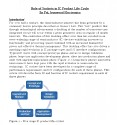For over half a century, the semiconductor industry has been governed by a commonly known principle described as Moore’s Law. This “law” predicts that through technological advancement a doubling of the number of transistors per integrated circuit will occur within a given geometric area on regular 18 month intervals. The realization of this doubling effect over time has resulted in an ever-widening range of semiconductor (IC) devices exhibiting increases in functionality and processing speed combined with an increased demand for power and effective thermal management. This doubling effect has also driven a matching rapid evolution in IC package types and I/O interface configurations. Typical IC starts with concept/prototype phase, moves to design validation phase, leaps into application development phase, rides into production phase and ends with upgrade/replacement phase (Figure 1). During these phases innovative interconnects have kept pace with the rapid evolution in semiconductor technology. IC sockets have been developed for a complete range of performance requirements and I/O configurations for each of those phases. This article will describe form, fit and function of IC sockets requirement in each of those phases.
Advertisement
Learn more about Ironwood Electronics






